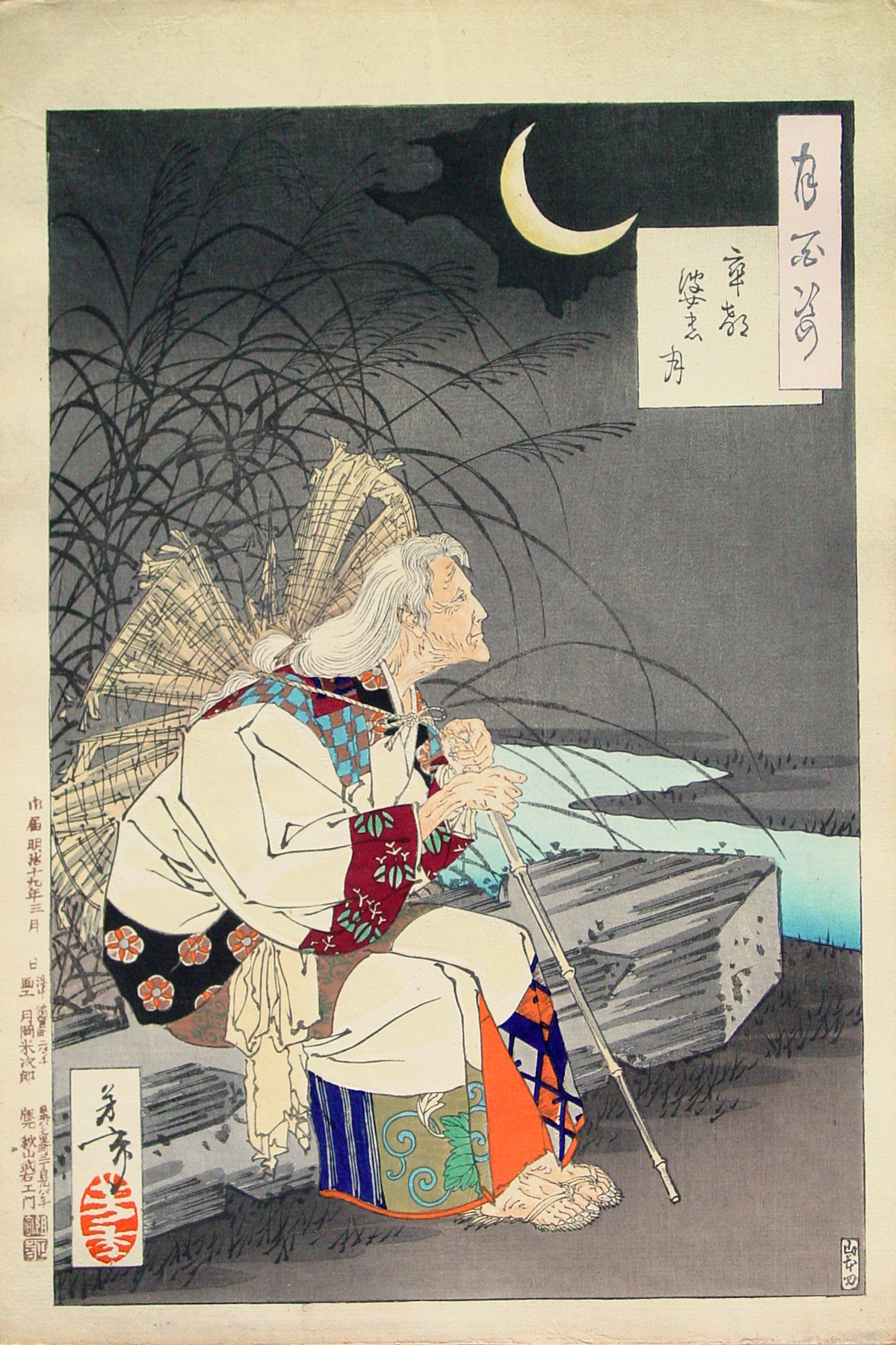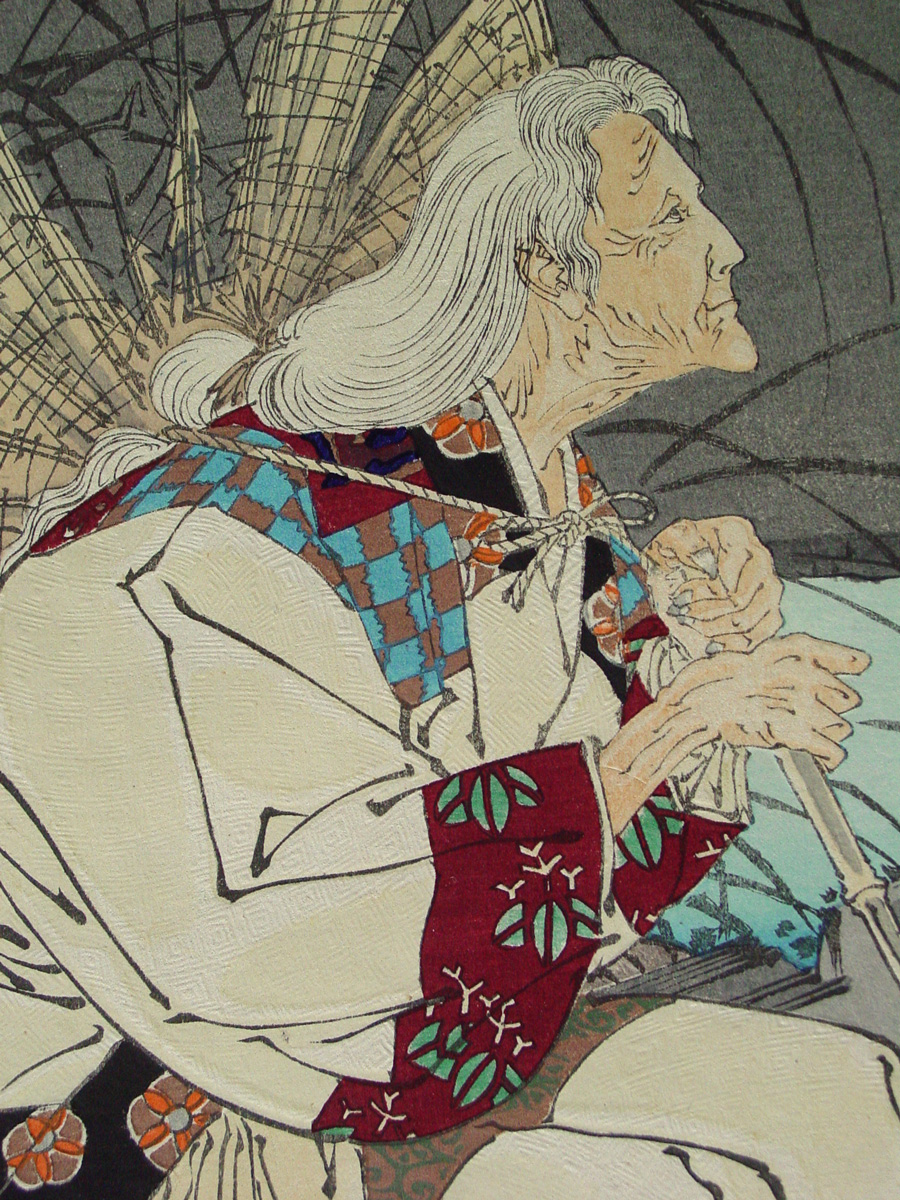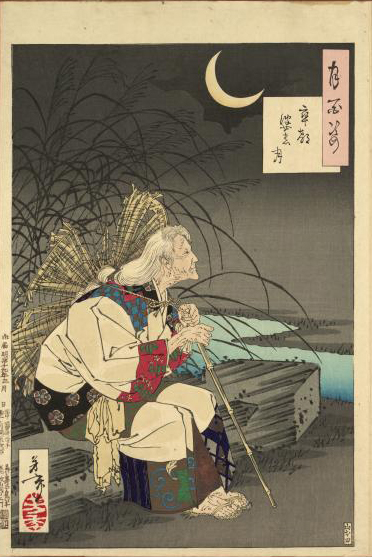About This Print
Source: Museum of International Folk Art http://www.internationalfolkart.org/exhibitions/past/moonweb/section1/010.htm
An early, if not first, state of this print.
The Story Depicted in the Print as Told by John Stevenson
Source: Yoshitoshi's One Hundred Aspects of the Moon, John Stevenson, Hotei Publishing, Netherlands 200125.
Gravemarker Moon
sōtoba no tsuki
Ono on Komachi was a famous beauty and poetess of the ninth century. She was the only woman in the group of rokkasen, “six poets,” who became a favorite theme of ukiyo-e prints and painting. She was often linked romantically with the most dashing of the group, Ariwara no Narihira. In one of the designs of Yoshitoshi’s New Forms of Thirty-six Ghosts, Narihira looks into a garden where he imagines he sees grass growing through the eye sockets of his lover Komachi’s skull, and ponders on the transience of life.
Episodes from Ono no Komachi’s life became the basis of a set of seven important Noh plays. The last of the group is called Sotōba Komachi (Gravemarker Komachi), the word sotōba being borrowed directly from the Sanskrit stupa. In the play, a destitute old lady sits down to rest on a fallen gravemarker. Two priests pass by and criticize her disrespect for the dead. She confounds them with her thoughtful and educated response. In amazement they bow down before her and ask who she is. Too ashamed to answer, she falls into a reverie. She remembers being courted in her youth and her cruelty to her suitors. The dream fades, and her anguish passes.
Komachi had much upon which to reflect. Blessed with beauty, a strong personality, and a brilliant intellect, she was favored by emperors and enjoyed the best minds of her day. She was the idol of the court – but this made her arrogant. She insisted that one of her lovers, a captain in the imperial guards, prove his ardor by waiting outside her door for one hundred nights. He survived ninety-nine, but was found frozen to death on the hundredth. The suffering she endured at the end of her life is sometimes interpreted as penance for this particular example of heartlessness.
A fashionable melancholy pervades many of Komachi’s poems. One anticipates the image of the “floating world” with a certain coquettishness:
I’m so lonely that I’d break off this sad body from its roots
and drift away like a floating reed – if the current were to beckon
Another forsees her situation in this print:
The flowers’ beauty faded but no one cared
I watched myself grow old in the world as the long rains fell
The rich brocade robes that the old lady wears in this design are based on the costume that Komachi would wear in the Noh play. Embossing on the robes enhances the richness of the print. These robes were called karaori, literally “Chinese weaving,” because they were derived from Chinese brocades – the term came to be used specifically for the ornate outer robes used in female roles. Komachi’s battered straw hat suggests the state into which she has fallen, while the susuki grasses behind her indicate the wildness of the overgrown cemetery.
The old lady still appears intelligent and beautiful in old age, as she sits lost in contemplation under a crescent moon. The moon is waning – a full moon would not be appropriate for this design. The grasses are still, the clouds stationary, and the image is filled with peace.
The Story as Told by Scripps College
Source: Scripps College website http://web-kiosk.scrippscollege.edu/Obj15503$31760
Object Description: Beneath drying autumn grasses, the aged Komachi sits gazing at the moon. Ono no Komachi was a beautiful, intelligent woman and one of the most accomplished early court poets. As a young woman she was pursued by many suitors, most of whom she heartlessly rejected. In her old age she became destitute and wandered about the outskirts of Kyoto reflecting on the world and the vanity of life. In the Noh play Komachi and the Grave Marker (Sotōba komachi), the aged poetess sits down on a gravestone to rest. Two passing priests criticize her disrespect for the dead, but she refutes their doctrinal arguments:
I too am a lowly buried timber
But if at heart, I've still blossoms,
Why should they not do for offerings?
Surprised that this beggar-like woman should be so intelligent and well read, the priests inquire her name, but the poetess cannot answer them for shame at her present state. She falls into a reverie and recalls her youth when she was being courted by one of her many suitors; when the memory passes she becomes calm again. Yoshitoshi's Komachi is dignified and still intelligent, alert, and beautiful in her old age. Her robe with its patches of different rich brocades is like the costume the protagonist wears in the Noh play.
Later she becomes possessed by the spirit of her unrequited lover Shii no Shosho, who pined to death for her, and she does a slow dance at the gravesite to his memory.
sōtoba no tsuki
Ono on Komachi was a famous beauty and poetess of the ninth century. She was the only woman in the group of rokkasen, “six poets,” who became a favorite theme of ukiyo-e prints and painting. She was often linked romantically with the most dashing of the group, Ariwara no Narihira. In one of the designs of Yoshitoshi’s New Forms of Thirty-six Ghosts, Narihira looks into a garden where he imagines he sees grass growing through the eye sockets of his lover Komachi’s skull, and ponders on the transience of life.
Episodes from Ono no Komachi’s life became the basis of a set of seven important Noh plays. The last of the group is called Sotōba Komachi (Gravemarker Komachi), the word sotōba being borrowed directly from the Sanskrit stupa. In the play, a destitute old lady sits down to rest on a fallen gravemarker. Two priests pass by and criticize her disrespect for the dead. She confounds them with her thoughtful and educated response. In amazement they bow down before her and ask who she is. Too ashamed to answer, she falls into a reverie. She remembers being courted in her youth and her cruelty to her suitors. The dream fades, and her anguish passes.
Komachi had much upon which to reflect. Blessed with beauty, a strong personality, and a brilliant intellect, she was favored by emperors and enjoyed the best minds of her day. She was the idol of the court – but this made her arrogant. She insisted that one of her lovers, a captain in the imperial guards, prove his ardor by waiting outside her door for one hundred nights. He survived ninety-nine, but was found frozen to death on the hundredth. The suffering she endured at the end of her life is sometimes interpreted as penance for this particular example of heartlessness.
A fashionable melancholy pervades many of Komachi’s poems. One anticipates the image of the “floating world” with a certain coquettishness:
I’m so lonely that I’d break off this sad body from its roots
and drift away like a floating reed – if the current were to beckon
Another forsees her situation in this print:
The flowers’ beauty faded but no one cared
I watched myself grow old in the world as the long rains fell
The rich brocade robes that the old lady wears in this design are based on the costume that Komachi would wear in the Noh play. Embossing on the robes enhances the richness of the print. These robes were called karaori, literally “Chinese weaving,” because they were derived from Chinese brocades – the term came to be used specifically for the ornate outer robes used in female roles. Komachi’s battered straw hat suggests the state into which she has fallen, while the susuki grasses behind her indicate the wildness of the overgrown cemetery.
The old lady still appears intelligent and beautiful in old age, as she sits lost in contemplation under a crescent moon. The moon is waning – a full moon would not be appropriate for this design. The grasses are still, the clouds stationary, and the image is filled with peace.
The Story as Told by Scripps College
Source: Scripps College website http://web-kiosk.scrippscollege.edu/Obj15503$31760
Object Description: Beneath drying autumn grasses, the aged Komachi sits gazing at the moon. Ono no Komachi was a beautiful, intelligent woman and one of the most accomplished early court poets. As a young woman she was pursued by many suitors, most of whom she heartlessly rejected. In her old age she became destitute and wandered about the outskirts of Kyoto reflecting on the world and the vanity of life. In the Noh play Komachi and the Grave Marker (Sotōba komachi), the aged poetess sits down on a gravestone to rest. Two passing priests criticize her disrespect for the dead, but she refutes their doctrinal arguments:
I too am a lowly buried timber
But if at heart, I've still blossoms,
Why should they not do for offerings?
Surprised that this beggar-like woman should be so intelligent and well read, the priests inquire her name, but the poetess cannot answer them for shame at her present state. She falls into a reverie and recalls her youth when she was being courted by one of her many suitors; when the memory passes she becomes calm again. Yoshitoshi's Komachi is dignified and still intelligent, alert, and beautiful in her old age. Her robe with its patches of different rich brocades is like the costume the protagonist wears in the Noh play.
Later she becomes possessed by the spirit of her unrequited lover Shii no Shosho, who pined to death for her, and she does a slow dance at the gravesite to his memory.
Image from Publisher's Bound Album (Issued shortly after Yoshitoshi's death)
About the Series "One Hundred Aspects of the Moon"For details about this series which consists of one hundred prints with the moon as a unifying motif, see the article on this site Yoshitoshi, One Hundred Aspects of the Moon.
Print Details
| IHL Catalog | #86 |
| Title | Gravemarker Moon (sotōba no tsuki 卒都婆の月) |
| Series | One Hundred Aspects of the Moon (Tsuki hyaku sugata 月百姿) |
| John Stevens Reference No.* | 25 |
| Artist | Tsukioka Yoshitoshi (1839-1892) |
| Signature | Yoshitoshi 芳年 |
| Seal | Yoshitoshi 芳年 |
| Date | March 1886 (御届明治十九年三月 日) |
| Edition | A single sheet issue, not bound into an album. An early state of the print. |
| Publisher | Akiyama Buemon (秋山武右エ門) [Marks: seal 26-132; pub. ref. 005] |
| Carver | carver Yamamoto 山本刀 [full name is Yamamoto Shinji] |
| Impression | excellent |
| Colors | excellent |
| Condition | good - light toning, margins slightly dusty, bottom margin lightlysoiled, upper corners creased, slight printer's creases on uppermargin, not backed (original state) |
| Genre | ukiyo-e |
| Miscellaneous | |
| Format | oban |
| H x W Paper | 14 5/8 x 9 7/8 in. (37.1 x 25.1 cm) |
| H x W Image | 12 7/8 x 8 3/4 in. (32.7 x 22.2 cm) |
| Collections This Print | Museum of Fine Arts, Boston 2016.929; Scripps College 97.1.17; Yale University Art Gallery 2011.143.1.25; Hagi Uragami Museum (Yamaguchi, Japan) UO1527; Tokyo Metropolitan Libary 加4722-48; The Tsubouchi Memorial Theatre Museum of Waseda University 201-4472; Ritsumeikan University ARC NDL-541-00-039; Worcester Art Museum 2002.191 |
| Reference Literature | * Yoshitoshi’s One Hundred Aspects of the Moon, John Stevenson, Hotei Publishing, Netherlands 2001, pl. 25. |




